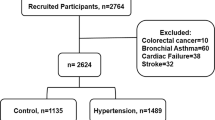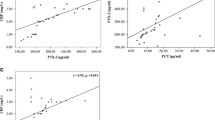Abstract
Hypertension is the most important public health problem in developing countries and one of the major risk factors for cardiovascular diseases, and it has been reported that hypertension is in part an inflammatory disorder and several workers have reported elevated levels of CRP in hypertensive individuals. The main aim of the present study was to evaluate the association between blood pressure and serum CRP levels across the range of blood pressure categories including prehypertension. A total of 104 patients and 63 control subjects were included in the present study. The level of CRP in the serum samples was estimated by a high sensitivity immunoturbidometric assay. Standard unpaired student’s ‘t’ test was used for comparison of hs-CRP levels between hypertensive patients and normotensive control subjects and between patient groups with different grades of hypertension and different durations of hypertensive histories. The mean serum hs-CRP level in hypertensive patients was 3.26 mg/L compared with 1.36 mg/L among normotensive control subjects (P<0.001). On comparison with normotensive control subjects, the hs-CRP levels vary significantly both with grades and duration of hypertension, with most significant difference found in patients with prehypertension (P<0.001), followed by Stage-I (P=0.01) and Stage-II(P=0.02) hypertensives. Significant difference in hs-CRP levels was also found in patients with shorter duration of hypertensive history (≤ 1year) when compared with those with ≥5 years of hypertensive history (P<0.01). Our study reveals a graded association between blood pressure and CRP elevation in people with hypertension. Individuals with prehypertension or with shorter duration of hypertension (≤1 Year) had significantly a greater likelihood of CRP elevation in comparison to chronic stage-I or stage-II hypertensives.
Similar content being viewed by others
References
Naomi DLF, Gordon HW. Hypertensive Vascular Disease. Harrison’s Principles of Internal Medicine. 16th Edition. Part Eight; Section Four; Chapter 246; 1463–1470.
Whelton PK. Epidemiology and the Prevention of Hypertension. J Clin Hypertens 2004; 6: 636–642.
King DE, Egan BM, Mainous AG 3rd, Geesey ME, et al. Elevation of C — Reactive protein in People with Prehypertension. J Clin Hypertens 2004; 6: 562–568.
Albert MA, Glynn RJ, Buring J, Ridker PM. C-Reactive Protein Levels Among Women Of Various Ethnic Groups Living in the United States (from the Women’s Health Study). Am J Cardiol 2004; 93: 1238–1242.
LI Jian-jun. Inflammation in hypertension: primary evidence. Chin Med J 2006; 119: 1215–1221.
Pauleto P, Rattazzi M. Inflammation and Hypertension: the search for a link. Nephrol Dial Transplant 2006; 21: 850–853.
Liby P, Ridker M, Maseri A. Inflammation and Atherosclerosis. Circulation 2002; 105: 1135–1143.
Ridker PM, Hennekens CH, Buring JE, Rifai N. C-reactive protein and other markers of inflammation in the prediction of cardiovascular disease in women. N Eng J Med 2000; 342: 836–843.
Danesh J, Whincup P, Walker M, Lennon L, Thomson A, Appleby P, Gallimore JR, Pepys MB. Low grade inflammation and coronary heart disease: prospective study and updated meta-analysis. BMJ 2000; 321: 199–204.
Koenig W, Sund M, Frohlich M, Fischer HG, Lowel H, Doring A, Hutchinson WL, Pepys MB. C-reactive protein, a sensitive marker of inflammation, predicts future risk of coronary heart disease in initially healthy, middle-aged men; results from MONICA (Monitoring Trends and Determinants in Cardiovascular Disease) Augsburg Cohort Study 1984–1992. Circulation 1999; 99: 237–242.
Ridker PM, Rifai N, Rose L, Buring JE, Cook NR. Comparison of Creactive protein and low-density lipoprotein cholesterol levels in the prediction of first cardiovascular events. N Engl J Med 2002; 347: 1557–1565.
Person TA, Mensah GA, Alexander RW, Anderson JL, Cannon RO III, Criqui M, et al. Markers of inflammation and cardiovascular disease: application to clinical and public health practice. A statement for health-care professionals from the Centers for Disease Control and Prevention (CDC) and the American Heart association (AHA). Circulation 2003; 107: 499–511.
Ridker PM, Stampfer MJ, Rifai N. Novel risk factors for systemic atherosclerosis: a comparison of C-reactive protein, fibrinogen, homocysteine, lipoprotein(a), and standard cholesterol screening as predictors of peripheral arterial disease. JAMA 2001; 285: 2481–2485.
Hirschfield GM, Pepys MB. C-reactive protein and Cardiovascular Disease: new insights from an old molecule. Q J Med 2003; 96: 793–807.
Di Napoli M, Schwaninger M, Cappelli R, Ceccarelli E, Di Gianfilippo G, Donati C, et al. Evaluation of C-reactive Protein Measurement for Assessing the Risk and Prognosis in Ischemic Stroke; A Statement for Health Care Professionals from the CRP Pooling Project Members. Stroke 2005; 36: 1316–1329.
Black S, Kushner I, Samols D. C-reactive protein. J Biol Chem 2004; 279: 48487–48490.
Boos CJ, Lip GYH. Elevated high-sensitivity C-reactive protein, large arterial stiffness and atherosclerosis: a relationship between inflammation and hypertension? J Human Hypertens 2005; 19: 511–513.
Sesso HD, Buring JE, Rifai N, Blake GJ, Gaziano JM, Ridker PM. C-Reactive Protein and the Risk of Developing Hypertension. JAMA 2003; 290: 2945–2951.
Sung KC, Suh JY, Kim BS, Kang JH, Kim H, Lee MH, Park JR, Kim SW. High-sensitivity C-reactive protein as an independent risk factor for essential hypertension. Am J Hypertension 2003; 16(6): 429–433.
Davey Smith G, Lawlor DA, Harbord R, Timpson N, Rumley A, Lowe GD, Day IN, Ebrahim S. Association of C-Reactive Protein With Blood Pressure and Hypertension. ArteriosclerosisThromb Vascular Biol 2005; 25: 1051–1060.
Fernandez-Real JM, Vayreda M, Richart C, Gutierrez C, Broch M, Vendrell J, Ricart W. Circulating interleukin 6 levels, blood pressure, and insulin sensitivity in apparently healthy men and women. J Clin Endocrinol Metab 2001; 86: 1154–1159.
Lakoski SG, Cushman M, Palmas W, Blumenthal R, D’Agostino RB Jr, Herrington DM. The Relationship between Blood Pressure and C-reactive protein in the Multi-Ethnic Study of Atherosclerosis (MESA). J Am Coll Cardiol 2005; 46: 1869–1874.
Wung BS, Cheng JJ, Chao YJ, Lin J, Shyy YJ, Wang DL. Cyclical strain increases monocyte chemotactic protein-1 secretion in human endothelial cells. Am J Physiol 1996; 270: 1462–1468.
Wang DL, Wung BS, Shyy YJ, Lin CF, Chao YJ, Usami S, Chien S. Mechanical strain induces monocyte chemotactic protein-1 gene expression in endothelial cells: effects of mechanical strain on monocyte adhesion to endothelial cells. Circ Res 1995; 77: 294–302.
Capers Q, Alexander RW, Lou P, De Leon H, Wilcox JN, Ishizaka N, Howard AB, Taylor WR. Monocyte chemoattractant protein-1 expression in aortic tissue of hypertensive rats. Hypertens 197; 30: 1397–1402.
Chobanian AV, Alexander RW. Exacerbation of atherosclerosis by hypertension: potential mechanisms and clinical implications. Arch Intern Med 1996; 156: 1952–1956.
Yasunari K, Maeda K, Nakamura M, Yoshikawa J. Oxidative stress in leukocytes is a possible link between blood pressure, blood glucose and C-reactive protein. Hypertens 2002; 39: 777–780.
Sinisalo J, Paronen J, Mattila KJ, Syrjala M, Alfthan G, Palosuo T, Nieminen MS, Vaarala O. Relation of inflammation to vascular function in patients with coronary heart disease. Atherosclerosis 2000; 149: 403–411.
Author information
Authors and Affiliations
Corresponding author
Rights and permissions
About this article
Cite this article
Shafi Dar, M., Pandith, A.A., Sameer, A.S. et al. hs-CRP: A potential marker for hypertension in Kashmiri population. Indian J Clin Biochem 25, 208–212 (2010). https://doi.org/10.1007/s12291-010-0037-7
Published:
Issue Date:
DOI: https://doi.org/10.1007/s12291-010-0037-7




